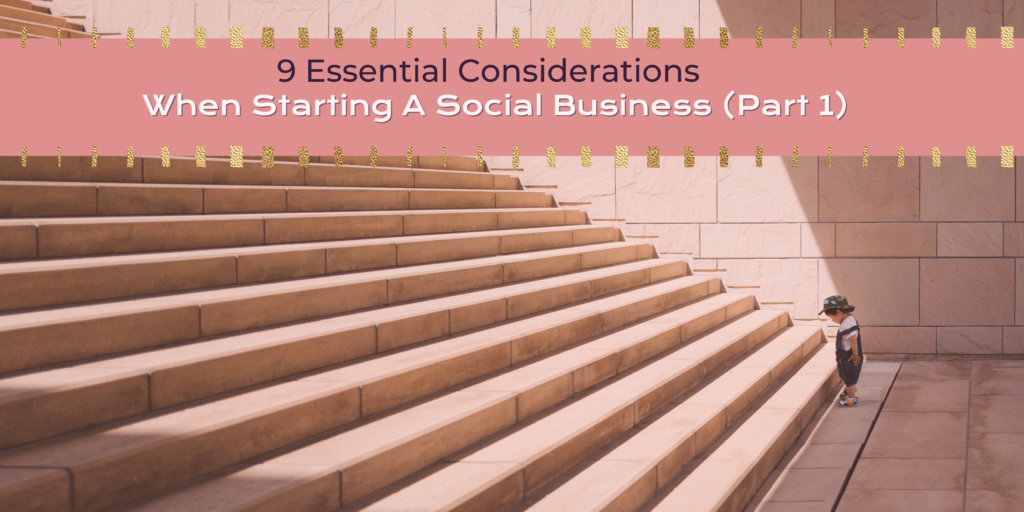Top 9 Considerations When Starting
The Social Business of Your Dreams
(Part 1 of 2)
Starting and running a profitable business is hard. Delivering outstanding programs or offerings that truly improve the lives of those you serve as a social entrepreneur is also hard.
Doing both is much harder. At times it can even feel impossible to join these sometimes conflicting goals in harmony.
My hope is that sharing these 9 tips will speed up the learning curve for social entrepreneurs just starting out. Even if it makes only a small dent in the number of times you think, “wow, I definitely would have approached that differently if I were starting over…”.
In many ways these considerations are lessons learned along my journey building theSedge.org, an online community that provides social enterprise learning opportunities to social innovators around the world.
Others are areas where I see the social entrepreneurs I work with struggle.
Not all of these tips apply to every social business, or social enterprise, so take in what resonates with you and leave the rest. There is no wrong way of building business, despite how experts position “fail-proof strategies” and systems guaranteed to lead you to success.
Plus, keep in mind this list is not necessarily in order of importance! The most important factors to look out for when starting out will depend on your unique strengths, the environment you operate in, and your social impact goals.
I am a big believer that everything happens for a reason, and so I have great respect for hard lessons learned along the way (more on failure here).
That said, at every stage along the journey we can always learn from those who blundered before us, right?
Like super small. As in, take your idea at its simplest and cut in half. I see this mistake so often and yes, am 100% guilty of it myself.
So how exactly do you start small when you have a BIG idea?
Try and break your idea down into all of it’s individual pieces. Think through each one of the elements of your social enterprise and ask yourself, “could my idea survive, or deliver value to my customers, without this?”. If the answer is yes, you don’t need it in your first iteration. If the answer is no, start with that element at the core of your business development.
One reason it’s easy to get swept up and “over-build” at the early stages of your business is that there tends to be an urge to wait until everything is perfect. And the fact is, everything will NEVER be perfect! So, you just keep tweaking and building and adding until it feels right to launch or get started officially.
Classic mistake. We need to remember as social entrepreneurs that we will never feel ready. Sometimes it’s only when you look back that you see how far you’ve come that you realize how those leaps of faith allowed you to be where you are today.
In a lot of ways, taking the leap forward before you feel ready is what sets changemakers apart! It comes with the territory of being a leader and creating innovative new solutions when others don’t necessarily see them as possible.
Once you know for certain your core idea is working on a small scale, usually it’s at that point that it really makes sense to start looking into building in the infrastructure to support your working model, and adding on new helpful features. I’ve never meet an idea that didn’t shift or evolve at least a few times before it really got to the place where it’s ready to take off!
[Tweet “#StartSmall: It’s easy to “over-build” in early stages of business because there’s an urge to wait until everything is perfect. #socent #tips”]

Recently, a Sedge member wrote in looking for more examples of organizations similar to the social enterprise she wanted to start up. In this instance, the organization she was hoping to model after had an extensive online presence and technology that allowed for donations and other neat tech features. She was tempted to look into similar technology solutions that could work for her, too.
Technology is a fantastic tool for scaling and streamlining processes. But, almost every process we imagine absolutely needing technology to perform for us, can also be accomplished manually.
The danger in building out the key components of your business (website technology especially) before you really have an idea of how your entire business and impact models will work, and exactly how you are providing value to all stakeholders involved, is that you might learn they needed something completely different from you!
The core value delivered often stays the same (your “why”; your mission) but the way you end up delivering the value could really change.
So, in the beginning don’t worry about setting up all the bells and whistles that you’ll eventually need to support a growing business. Try and first manually replicate what you would eventually want your technology or processes to do for you.
Once the project is working for you in a predicable and valuable way, then you KNOW for sure it makes sense to invest your valuable time and resources into more complicated infrastructures, such as a fancy website.
[Tweet “#GoManual: Manually replicate what you would eventually want your technology or processes to do for you. #socent #tips”]

One of the challenges entrepreneurs face over and over again is the feeling of overwhelm.
You know that feeling where you’re certain your do to list is going to leap off the desk and drown you one email and tech challenge at a time? It’s easy to get lost in the cycle of putting out urgent fires, or handling the squeaky wheels. And then focus for the most important tasks can get lost in the chaos.
Often, entrepreneurial overwhelm can be combated by first acknowledging it and then stepping back to reflect on how you can better set yourself up for success. This gets you out of the hamster wheel long enough to become of aware of your patterns that work against organization and productivity.
Another way to combat overwhelm to always ask yourself, “can I do this in a simpler way?” (See #1 above.)
This article dissects how different “brain types” contribute to overwhelm. Once you identify how your personality and thinking may be contributing to the overwhelm, you can counteract it more strategically. And here’s another article with 10 quick tips you can try out to combat overwhelm.
[Tweet “#CombatOverwhelm: Always ask yourself, “can I do this in a simpler way?”. #socent #tips”]
As passionate social entrepreneurs, it can be tempting to think very long term and design your social enterprise with a huge vision of impact. Of course this vision is needed to drive transformative new change, but it can also be a real hurdle as a new social entrepreneur.
The problem with big visions is that they often require massive infrastructure and systematic partnerships to put into action. When the project is bootstrapped (self-funded and/or funded from revenue) the time to reach positive cash flow may be too long.
Meaning, unless the project is funded through start up grants, a parent organization or philanthropic donors, building up revenue may take much longer than your ability to cover expenses from personal resources, or cash coming into the business from clients.
One way to combat this challenge is to plan a “fastest-path-to-the-cash” short-term strategy for your social business. This can certainly transition to, or build into, the longer term vision but at least your business will be up and running sustainably early on.
Two ways that typically offer the the “fastest-path-to-the-cash” are:
1. Trading your time for money. Offer a service of value where you will be directly compensated for your time.
2. Sell physical products for a higher price than you bought them for (classic mark-up).
Once you have reached a certain level of financial security with these “fastest-path-to-the-cash” strategies, then you can work on building in leverage and systems to grow into your big picture vision for impact.
[Tweet “#FastestPathToTheCash: Vision drives transformative change, but is also a hurdle as a social entrepreneur. #socent #tips”]
Read Part Two of this post, where we cover the final Top 5 Considerations When Starting the Social Business of Your Dreams:
#5 – LISTEN TO YOUR CUSTOMERS
#6 – SELL THEM WHAT THEY WANT,
GIVE THEM WHAT THEY NEED
#7 – PARTNER WITH THOSE ALREADY DOING THE WORK
#8 – GROW SLOWLY
#9 – PURPOSE OVER PATH


